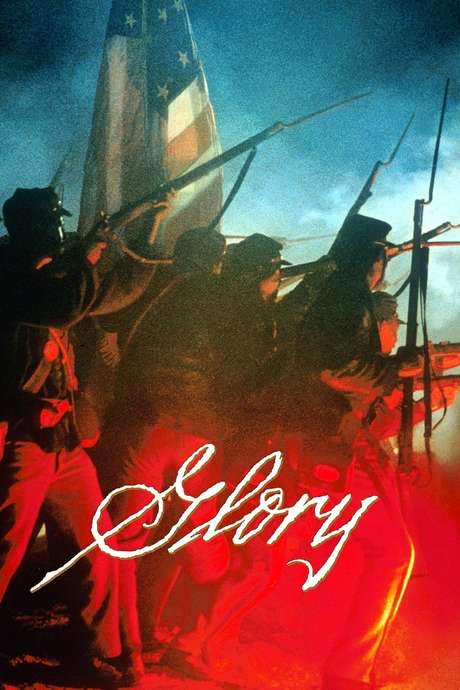
Glory
Year: 1989
Runtime: 122 mins
Language: English
Director: Edward Zwick
They are innocent, their heritage and lives at stake. Robert Gould Shaw commands the Union’s first all‑Black volunteer regiment, the 54th Massachusetts, confronting prejudice from both his own army and the Confederate forces. Their courage challenges entrenched racism and proves their worth on the battlefield.
Warning: spoilers below!
Haven’t seen Glory yet? This summary contains major spoilers. Bookmark the page, watch the movie, and come back for the full breakdown. If you're ready, scroll on and relive the story!
Glory (1989) – Full Plot Summary & Ending Explained
Read the complete plot breakdown of Glory (1989), including all key story events, major twists, and the ending explained in detail. Discover what really happened—and what it all means.
During the Civil War, Captain Robert Shaw is wounded at Antietam and returns home to Boston on medical leave. Shaw, elevated to Colonel to command the 54th Regiment Massachusetts Volunteer Infantry—one of the Union Army’s first Black regiments—asks his friend Maj. Cabot Forbes to serve as his second in command. Their first volunteer is a mutual friend, Thomas Searles, a bookish, free African-American. Other recruits quickly join the ranks, including John Rawlins as a trusted aide, Pvt. Jupiter Sharts, a mute drummer, and Pvt. Trip, a wary young man who will grow into his role in the regiment.
After the Emancipation Proclamation, the men of the 54th learn a brutal fact: the Confederacy plans to execute any Black soldiers captured in Union uniforms along with their white officers. Despite this deadly threat, the volunteers refuse an offer to be honorably discharged and endure demanding training under the stern discipline of Sgt. Maj. Mulcahy. Tensions rise when Trip is arrested for AWOL and flogged; Shaw discovers the root cause—Trip had left camp to replace worn-out shoes. Shaw confronts the base’s racist quartermaster, who has been withholding supplies. When the men find out that the Federal government pays Black soldiers about three-quarters the salary of white soldiers, Trip urges a collective refusal of pay, and Shaw tears up his own pay stub in solidarity. In recognition of his mentorship and his empathy for the troops’ morale, John Rawlins is promoted to Sergeant-Major.
Once the core is formed and the men are properly trained, the 54th comes under the command of Gen. Charles Garrison Harker and is ordered by Col. James Montgomery to sack and burn Darien, Georgia. Shaw initially refuses this directive, but agrees under the threat of being relieved of duty. He’s increasingly tired of seeing his men used for brutal labor and raids on civilians, and he makes clear to Harker and Montgomery that he will report profiteering to the War Department unless the 54th is given a true combat assignment.
The regiment then goes into action at James Island, South Carolina, repelling a Confederate assault. Thomas Searles is wounded in the action but saves Trip’s life in the process. Shaw offers Trip the honor of bearing the regimental flag in battle, but Trip declines, uncertain that the war will bring about a better life for enslaved people.
General George Strong later informs his regimental commanders of a major campaign aimed at securing a foothold at Charleston Harbor, describing the initial assault on Morris Island and the frontal assault required on Fort Wagner. Shaw volunteers the 54th for the mission. The night before the attack, the Black soldiers hold a religious service, give thanks, and seek divine assistance. The next morning, the 54th advances to the assault amid cheers from Union troops who had previously taunted them.
The assault on Fort Wagner is devastating; the 54th suffers heavy losses as they advance across the open beach and take cover in the dunes as darkness falls. Shaw is killed while trying to rally his men. Trip lifts the regimental flag and leads the survivors toward the fort, brandishing the banner until he is mortally wounded. Forbes leads a party into the fort’s outer defenses where Charlie Morse is killed, and Thomas is wounded. A small number of survivors, including Forbes, Rawlins, Thomas, and Jupiter, press forward to face a Confederate gun, and the screen fades to black, implying their deaths.
In the days that follow, Confederate soldiers remove the bodies of Union troops from the beach, raise the Confederate flag over the fort, and bury the fallen in a mass grave. Shaw’s body slides into the same trench where Trip lies, a stark image of the cost of battle. An epilogue notes that although Fort Wagner was never captured, the courage displayed by the 54th helped persuade the Union Army to recruit thousands of Black soldiers for combat—a turning point President Abraham Lincoln credited with helping to shift the war’s momentum.
Last Updated: October 09, 2025 at 14:30
Unlock the Full Story of Glory
Don't stop at just watching — explore Glory in full detail. From the complete plot summary and scene-by-scene timeline to character breakdowns, thematic analysis, and a deep dive into the ending — every page helps you truly understand what Glory is all about. Plus, discover what's next after the movie.
Glory Timeline
Track the full timeline of Glory with every major event arranged chronologically. Perfect for decoding non-linear storytelling, flashbacks, or parallel narratives with a clear scene-by-scene breakdown.



